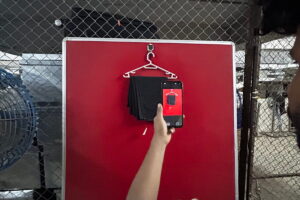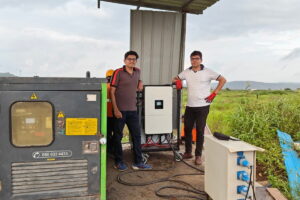When Reel And Real Stories Create Impact
Nov 10, 2025 | Pratirodh Bureau
A film set in Ramoji Film City. The film, television and online curated content industry in India generated about a trillion rupees in 2024-25. However, their carbon footprints are equally huge, with big-budget films averaging 3,370 metric tons (Representative image by Ankur P. via Wikimedia Commons)
- In a traditionally resource-heavy industry, a growing community of people inclined toward sustainability are bringing small changes and innovative ideas to film sets.
- New roles are emerging in India’s film industry, as sustainability consultants, renewable energy engineers, and circular economy entrepreneurs work to reduce the carbon footprint of film productions.
- The rise of eco-conscious professionals reflects a small shift toward green jobs in the creative economy, where environmental awareness and efficiency are becoming part of the skill set for future work in the industry.
- However, attracting or retaining sustainability professionals in an industry known for difficult work environments and different priorities, is a challenge that many who have made inroads are still navigating.
Everything about the movies is vast — the screens, the drama, the locations, the music, the emotion. Most of us frequent this portal between fiction and reality with the excitement of those hungry for stories, glamour, connection, fashion, all designed for you to step into a world different than yours and still in so many ways, exactly the same.

Films are larger than life. With a considerable economic footprint. The broader film, television and online curated content industry in India generated about a trillion rupees in 2024-25. The movie and entertainment segment in particular, raked in a revenue of about half a trillion rupees in 2023, and is forecast to go up to more than double, hitting almost a trillion rupees, by 2030 under current trends.
Larger than life, indeed, even behind the scenes.
According to this article by Social Policy Research Foundation, “The data from tentpole productions (big-budget films with budgets over ₹800 million) in India showed an average carbon footprint of 3,370 metric tons — or about 33 metric tons per shoot day. For context, this daily carbon footprint is almost as much as the carbon footprint of about 3,000 one-way flights from Mumbai to Delhi.
What does this mean? Simply put, it’s a lot.
In an industry that is far from being ‘green’, a small community of people are working to scale the sustainability mountain. Former film professionals, engineers, and designers are turning entrepreneurs to mitigate the industry’s growing impact on the climate.
Second take
A film set, even at its most structured, is a chaotic space. It’s the nature of the beast. A place of tough hours, literal constructions coming up in days, costumes being created, hundreds of people working together, creative energies and egos overlapping and warring, and sky-high costs of a single day’s production.

Some of the waste from film sets finds its way to landfills after a brief use in the form of plywood, polystyrene (Thermocol) and plastic, most of them forming elaborate but temporary sets. For decades, use and throw has been part of the larger business processes. “Ironic, as our traditional thought processes have always been around savings, of things, of money,” says Saurabh Kabra, Director of Vault, a business that offers storage solutions that encourage reuse.
Having been part of the entertainment industry as a filmmaker for 20 years himself, Kabra understands the challenges of going green. He believes a good story can bring about change, and there are filmmakers doing that job, but that sort of impact, while necessary, is slow. Audiences might be inspired by messaging in a film but that does not translate into behavioural change quickly. “We don’t have much time,” he says. “I am in my 40s and have 20-30 good years left, and I want to create relevant impact. Let those people make the good stories, I will do the boring, tedious work of bringing about process changes.” And that’s how Vault came into existence.
Vault offers storage at a fee — of sets, clothes, props, whatever studios and production houses want to store, and according to the area requirement and time. “When you pay for area as needed, it saves on the rent you would otherwise use in a warehouse somewhere,” says Kabra. “Most studios lose track of the items they have stored in warehouses. We itemise all of it with a QR code, according to type, colour, size. For example, if you had three police uniforms made for an older film or a mural or a prop, all you need to do is login to your account, search for what you need and reuse for the next film. Kabra also encourages his clients to rent items out to each other. He plays matchmaker for need and supply and in the process, helps his clients not just store their stuff to reuse later but also make some additional money from renting it out. At five years, this is a hopeful start for Kabra. His clientele is largely production houses.
Waste is relative when it comes to different industries. The Malayalam film industry uses live locations most of the time instead of erecting sets. Aaron Mathew, an associate director, says, “We don’t have big studios here, unlike Bollywood, just a few small spaces for specific scenes. Creating a set (small or large) is rare. We might add a wall or a small section to depict something that is unavailable for shoot. For example, the cave in Manjummel Boys had to be made but everything else was at live locations.” Live location filming is the norm here, usually chosen for authenticity or budget restraints. The unintended benefit is perhaps less waste.
Behind the green screen
Diesel generators are commonly used on film sets to power lights, LED panels, LED screens, audio systems and production control rooms, contributing to the overall production emissions. Amit Malakar and Sandeep Sonpakti, co-founders of SmartBatt Energy Solutions are attempting to minimise these emissions through cleaner and more efficient power alternatives for the film production and event industry. While both studied to be electronic engineers, Malakar worked in the electrical vehicle industry which formed a blueprint for this entrepreneurial venture.

“Each litre of diesel burnt generates about 2.7 kg to 3 kg of carbon dioxide. For sets that go on for 10-12 hours, you’re burning almost 80 litres of diesel. And that’s just one small DG set on one set. The efficiency of conversion is only 35%. The rest 65% of energy is going waste as heat, noise and pollution,” he says.
SmartBatt provides temporary power as per requirement of time and volume, already stored in a Portable Power Station, consisting of an energy storage battery (lithium), a power conversion system and an energy management system.
The battery draws energy from the grid and stores it for use. “It’s like the lithium batteries used in electric vehicles,” says Sonpatki. “You can charge them when needed. They last up to eight to 10 years and are reusable, reconfigurable. Parts of them will be repurposed so there’s circularity there. These are safer, with no noise, no fumes, no long cables outside sets, and very little maintenance. It’s basically clean energy with no fluctuations, unlike diesel generated power. And it’s cheaper. These typically end up saving end consumers roughly about 20% by 30% over a diesel generator.”
Sustainability as supporting cast
For engineers, renewable energy spaces are now serious career options, be it electronics, civil (working on a dam) or construction (putting up solar plants). And for films, it needs a matchmaker that can utilise these services.
Cue Siddharth Nakai, a sustainability consultant and Founder of GAME (Green Advertising Media and Entertainment). Nakai gets involved right from the pre-production stage by calculating the environmental footprint of a film with parameters like fuel used, number of generators, travel, etc. He also ensures waste segregation and management becomes part of the process. Then, he lays down affordable measures that can be adopted. For example, if they have 10 cars on set, can one or more be EVs? Can they use re-usable materials and costumes on set?
To Nakai, sustainability on film sets is also about inculcating a culture of care and safety: first towards human life, and then towards the environment. It’s important that the crew operates in an optimum work environment, and has tools to prevent accidents. The outreach for environment sustainability is the next step.

“We also try to bring this thought to screen,” he says. “We came up with a campaign for Kaun Banega Crorepati where for every wrong answer a contestant gave, the corporation pledged to plant 100 trees (with the help of an ecologist).” Aisa Yeh Jahaan (2015), touted as India’s first carbon neutral film, did something similar ten years ago. Director Biswajeet Bora worked with the Centre of Environment Research (CERE) to do an environment audit for the film and ensured the plantation of the required number of trees to offshoot the carbon footprint. Something that has not been replicated successfully ever since.
Making movies is an expensive business and sustainability on set is not a priority for most. Also, sustainability is implemented more in structured industries that are governed by various laws and regulations in India. That is not the case for the entertainment industry, with no real regulation from an ESG perspective.
Nakai says, “Initially no one would even use a reusable water bottle on set but at least now people are taking accountability, especially post COVID, and there are jobs that have been created specifically around sustainability in corporations. I work with the sustainability leads at Sony and Amazon regularly in terms of their processes.” Nakai studied Business of Film Entertainment, a marketing and branding related course at MICA and upskilled with a Green Building Certification, a course from the International Sustainability Alliance Australia, ESG certifications as well, just to understand how to mitigate issues on set.
He recognises the limitations of retaining talent for this type of work. “Film work is on an ad-hoc, need-based, short-term cycle and the kind of remuneration is lower in the environmental field than in others so talent is hard to come by.” Add to that the chasm of uncertainty between the expectation that someone with a Master’s degree in Sustainability comes in with, versus the reality of set work. “Also, people who have studied this subject in its truest form might not want to spend 12-13 hours on set,” says Nakai.
But he takes it one set at a time, even once spending his own money to build a filtration system on set to replace plastic bottles. “It still took live testing of the water and putting up the results for the crew to see for them to trust that it was as clean as bottled water,” says Nakai.
In the Malayalam industry, Mathew points out how most of the teams use steel plates and glasses at meals. “It’s a smaller industry, with smaller budgets, but even when budgets improved, I noticed the steel vessels remained. No disposables on most sets. Costumes get reused for junior artists, but not for the leads.”
Charting your own path
We are only scratching the surface with reuse and recycling concepts for costumes. Globally, thrifting is becoming a trend — also referred to as ‘pre-loved’, which is an endearing spin on the messaging. But it is not the norm in India. Theia Tekchandaney, costume designer and stylist, works to the brief.

“Depending on the need, we create or thrift. For example, we just finished a war film, so that had to be designed from scratch. But another small film in Lucknow had a Diwali party scene with 40 people to dress, and the clothes needed to look well-worn. Instead of buying them from a branded store, where we’d need to age them by using sandpaper, potassium, tea water and wash them multiple times, we went to Chor Bazaar (known as the largest flea markets in India).”
Tekchandaney works on an individual level, attempting a green job in an industry far from green. She starts all projects with a conversation about the possibilities of mitigating waste. “It depends on budgets, timelines, if the director and producer aligns with the vision and what the movie needs, because that is the job I have to deliver.” The basics are now almost muscle memory for her team — sourcing with their own bags; to plan routes and days to prevent multiple trips to the same neighbourhoods; ensuring no over-ordering food, keeping waste fabric for reuse. “These are not really novel things, it’s just a mindset that says I have to do this, every day of my life.” And now after her consistent efforts, her repeat collaborators from production houses like Vikesh Bhutani’s Chalkboard Films and Ram Madhvani Films discuss what costumes and accessories can be stored and reused after shoots.
Small steps, bigger challenges
Globally, alliances have formed in different entertainment industries — Albert, BAFTA, German Federal Film Board, etc. — to put down guidelines for greener processes. In India, Anupama Mandloi is putting together the India Sustainability Entertainment Alliance (ISEA) with Nakai, an idea whose time might have arrived. Mandloi is the Regional Ambassador for the Global Impact Producers Alliance and the Founder of India GreenSet and co-founder — The Impact Collective — all organisations focused on social impact, including sustainability, into the entertainment industry.
As a filmmaker, Mandloi is an industry insider herself. While the conversations with studios and producers about using more sustainability guidelines on sets haven’t gone so encouragingly, she is determined to dig in her heels. “Sustainability is such an abused word,” she says. “To me, it just means efficiency — optimum use of all your resources, and make it a space that is inclusive, safe and create a platform where people thrive.” Through her associations with various groups, she is pushing for moving beyond the bare minimum happening on sets and for the conversation to go beyond self-benefit and looking outward towards the rapid degradation of climate and perhaps affect policy someday.
While there are small steps towards a larger change, the uptake by the industry is still low. Nimish Kotwal, an acclaimed production designer came up with The Wall Company, where he rented readymade backdrops for sets. This would replace construction for new sets wherever possible, preventing waste and reducing resources. But he met with more failure than success. For now, he continues working as a production designer, and his walls wait for the time the industry is ready.
It does seem that the time for innovations is now. Sajeeth Nambiar, founder of a start-up called Circulenz.Ai, is developing an AI-powered tool that analyses scripts to identify opportunities for prop/set reuse and recommends sustainable alternatives before shoots begin. After spending a decade in India’s event and entertainment industry, he understood the environmental challenges of traditional set design and transitioned into film sustainability research, focusing on green technologies and circularity. “Real-world analysis shows medium- to long-term savings, reduced spend on materials, lower waste disposal fees, and often improved efficiency. Reusing props/sets and sourcing materials smartly can cut procurement costs by 20-40%,” he says.
Kabra reiterates, “You only need a handful of people to start something. If the idea allows for a sustainable process that is also cost-effective, the masses will follow.”
(Published under Creative Commons from Mongabay India)
